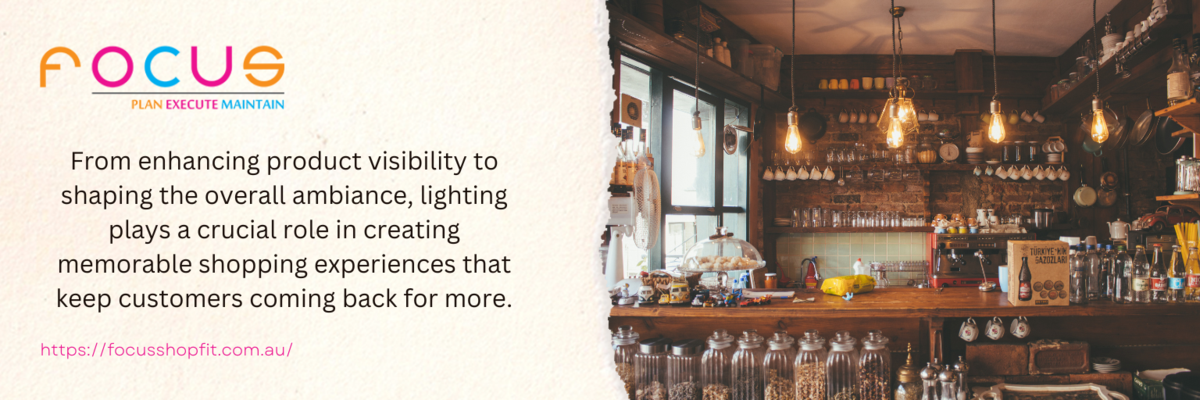In retail, where every square meter counts and every customer interaction is crucial, shopfitting holds significant importance. Shopfitting encompasses the intricate process of designing and fitting out retail spaces to optimize functionality, aesthetics, and ultimately, sales. Among the myriad elements that contribute to a successful retail environment, lighting design stands out as a powerful tool for transforming the ambiance, highlighting merchandise, and creating an immersive shopping experience.

Shopfitting is paramount for businesses striving to stay ahead of the curve. Whether you’re revamping an existing store or embarking on a new retail venture, understanding the principles of lighting design and its impact on your store fitout can make all the difference in elevating your retail space and captivating your audience.
The Power of Lighting Design
Imagine walking into a dimly lit store versus one bathed in warm, inviting light. The difference in ambiance is palpable, setting the tone for the entire shopping experience. Lighting design is not merely about illuminating a space; it’s about crafting an atmosphere, guiding customers through your store, and accentuating your merchandise. In shopfitting, lighting serves multiple purposes:
- Highlighting Products: Effective lighting draws attention to key products, showcasing them in the best possible light—both literally and figuratively. Whether it’s a spotlight on a featured item or subtle accent lighting to create visual interest, strategic placement of lights can significantly influence purchasing decisions.
- Creating Ambiance: Lighting sets the mood and ambiance of your store, shaping the overall experience for customers. From bright, energetic lighting in active retail areas to soft, ambient lighting in relaxation zones, the right lighting scheme can evoke emotions and enhance the shopping journey.
- Improving Visibility: Good lighting isn’t just about aesthetics; it’s also about practicality. Proper illumination improves visibility, making it easier for customers to navigate your store, locate products, and read labels or signage. Inadequate lighting, on the other hand, can lead to frustration and detract from the overall shopping experience.
- Enhancing Brand Identity: Your store’s lighting design should reflect your brand identity and values. Whether you’re aiming for a minimalist, modern aesthetic or a cozy, rustic ambiance, lighting plays a crucial role in reinforcing your brand image and resonating with your target audience.

Key Considerations in Lighting Design for Retail Spaces
When embarking on a store fitout or renovation project, careful consideration of lighting design is essential. Here are some considerations to keep in mind when picking lighting for your store:
- Natural vs. Artificial Light: While natural light is often prized for its ability to create a sense of openness and connection to the outdoors, it’s not always feasible to rely solely on daylight, especially in indoor retail environments. A well-balanced combination of natural and artificial lighting can maximize energy efficiency while ensuring consistent illumination throughout the day.
- Color Temperature and CRI: The color temperature of light (measured in Kelvin) and its Color Rendering Index (CRI) have a significant impact on how merchandise appears to customers. Warm, yellow-toned light can create a cozy, inviting atmosphere, while cooler, blue-toned light may convey a sense of brightness and freshness. Understanding the interplay between color temperature and CRI is crucial for achieving the desired ambiance and accurately representing product colors.
- Layered Lighting: Effective lighting design often involves layering different types of lighting to achieve depth and dimensionality. This may include ambient lighting to establish a base level of illumination, task lighting to highlight specific areas or products, and accent lighting to add drama and focal points. By layering lighting sources strategically, you can create visual interest and guide the customer’s eye throughout the space.
- Flexibility and Adaptability: Retail environments are constantly evolving, with changing product displays, seasonal promotions, and shifting customer preferences. A well-designed lighting system should be flexible and adaptable, allowing for easy adjustments to accommodate varying merchandising layouts and promotional campaigns.
- Energy Efficiency: In an era of heightened environmental consciousness, energy efficiency is a key consideration in lighting design. LED lighting technology has revolutionized the retail lighting landscape, offering significant energy savings, long lifespans, and versatility in color temperature and intensity. By incorporating energy-efficient lighting solutions into your store fitout, you can reduce operating costs and minimize your environmental footprint.
Illuminating the Path to Retail Success
The importance of lighting design in retail store fitouts cannot be overstated. From enhancing product visibility to shaping the overall ambiance, lighting plays a crucial role in creating memorable shopping experiences that keep customers coming back for more. By understanding the principles of lighting design and leveraging innovative lighting solutions, retailers can elevate their retail spaces, strengthen their brand identity, and ultimately, drive sales and customer loyalty.

As you embark on your own shopfitting journey, remember that lighting is not just a practical necessity but also a powerful tool for storytelling, brand expression, and creating emotional connections with your audience. So, dare to dream big, experiment with different lighting techniques, and let your retail space shine bright as a beacon of style, innovation, and inspiration in the Australian retail landscape.
